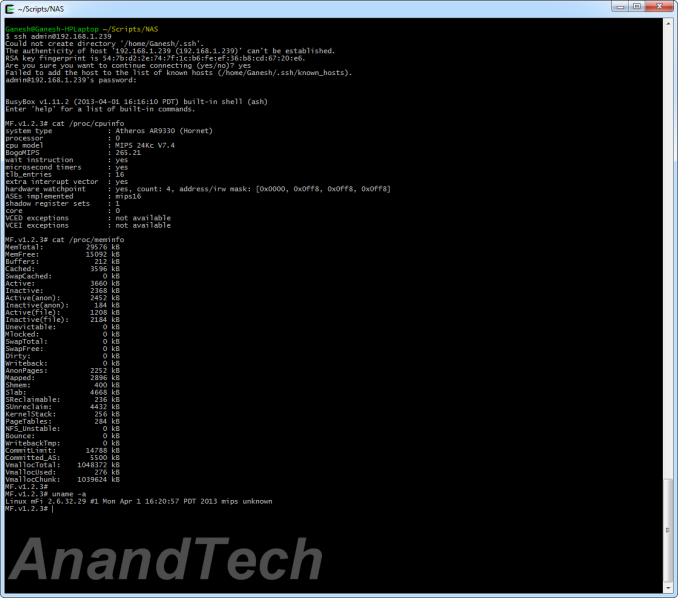Ubiquiti Networks mFi mPower Wi-Fi Power Strip Review
by Ganesh T S on November 21, 2013 3:00 AM EST- Posted in
- Home Automation
- Wi-Fi
- Ubiquiti Networks
- IoT
Inside the mPower
The mPower can be accessed and controlled via SSH even without linking it with a mFi host. In this case, the SSH login credentials are the default (ubnt/ubnt). The mPower unit runs Linux under its hood, with BusyBox providing much of the needed access functionality. The unit uses the Dropbear SSH server service. Accessing the unit over SSH gives us some insight into the core platform.
The mPower uses the Atheros AR9330 Hornet platform (more commonly found in wireless access points / low end routers such as this one) for its networking functionality and host CPU. The unit has 16 MB of RAM. The more interesting aspect is the chip used for collecting the electrical parameters. Ubiquiti takes pride in the fact that the electrical statistics are gathered by utility-grade ICs rather than the ADCs employed by other competing solutions. The mPower uses the Prolific PL7223 for gathering the electrical parameters. The PL7223 is apparently popular in these circles, as it also finds a place in GainSpan's SmartPlug kit. At this price point, it would be unfair to expect solid-state relays. So, we do have the clicking sounds when outlets are turned on or off.
FCC reports for all of Ubiquiti's products are linked on this page. We could have torn down the mPower unit ourselves, but, with the details of the platform evident from gaining SSH access, we leave it to the photographs provided in the FCC submission. They are reproduced in the gallery below.
In the next section, we will look into taking advantage of SSH for the development of custom applications.

















61 Comments
View All Comments
daar - Thursday, November 21, 2013 - link
Thanks for the review, introduction could use some work when it comes to chunking info about the product, though.darwinosx - Thursday, November 21, 2013 - link
Yeah it's not clear what this product does.ydeer - Thursday, November 21, 2013 - link
Glad I’m not the only one who is confused. At first I thought it is a 802.11 <-> powerline <-> CAT5 access point, but apparently it is a "X10-like" powerstrip with WiFi. I think?eli2k - Thursday, November 21, 2013 - link
can you access the power outlets with the device connected only to the wifi network and host w/the mFi software turned off? or do I always have to have a host computer running?ganeshts - Thursday, November 21, 2013 - link
Yes, this is possible. In fact, you can use the unit without even linking it to a mFi host. (Though you do need the mFi host to upgrade the firmware on the mPower, you can always uninstall the mFi from the host computer afterwards)simpsond - Tuesday, November 26, 2013 - link
I wrote a little library which will SSH into the mPower and run the appropriate commands to enable read/write, toggle the acutators, and sample the ports. It can be found here: https://github.com/dansimpson/mfiPhelerox - Thursday, November 21, 2013 - link
This product is really interesting because it's very similar to my Bachelor of Science thesis where we, between January and May of this year, made a working prototype of a smart power strip that (over WiFi) reports power consumption for its outlets to a Web server, and of course allows for remote controlling the state of the outlets on the website. The hardware has an 8-bit AVR microcontroller, WiFi, solid-state relays and measurement hardware on a custom PCB. The website uses Django and supports multiple users and multiple power strips per user (unfortunately we've only made one final prototype so far), and some basic automation functionality (though we didn't have time to implement most of our automation ideas, for example a location-aware smartphone app or IFTTT integration). I don't know if it interests anyone, but I'll provide a link to the report we wrote: https://www.dropbox.com/s/7zal1ajnhs0nnad/A_Smart_...Duodecim - Thursday, November 21, 2013 - link
I've been checking a lot of these home automation devices recently. Some years ago I had simple and cheap remote controlled power sockets, and I've been waiting for some progress and a standard to emerge. I remembered checking these specific Ubiquity devices, read about the Java software, but somehow missed the SSH functionality.I'm very interested in the openness of these devices, as I could write my own open-source software to run on an ARM mini-server or even a Meego/Sailfish phone application instead of being stuck with some closed and highly proprietary platform. It would also make it easier to check if some basic security has been implemented so hijacking these gadgets won't be too easy.
I hope some sort of standard emerges for these kind of devices and the sort of "intelligent" light bulbs like LIFX and Phillips Hue though, as a zillion different protocols, remotes and apps would ruin the experience and make life harder rather than easier.
I like the geek angle in this review, thanks!
Verdant - Thursday, November 21, 2013 - link
To me, the app glut is the part the ubiquity environment that needs to be solved first...zeebo - Thursday, November 21, 2013 - link
You're delaying the Macbook Pro review for stuff like a power strip? Come the hell on.